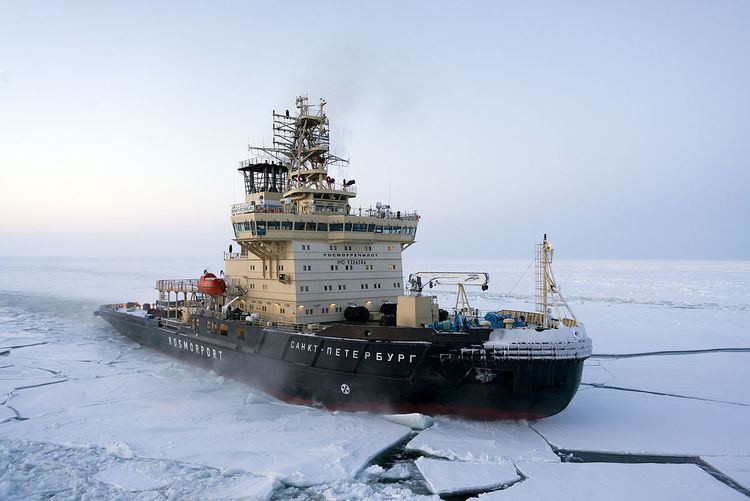Built 2008–2016 Completed 5 | Planned 5 Active 5 | |
 | ||
Builders Baltic Shipyard, Saint Petersburg, RussiaVyborg Shipyard, Vyborg, RussiaArctech Helsinki Shipyard, Helsinki, Finland | ||
Project 21900 and Project 21900M icebreakers (also referred as LK-16) are a series of five Russian icebreakers. Two project 21900 icebreakers (Moskva and Sankt-Peterburg) were built at Baltic Shipyard in Saint Petersburg in 2008 and three project 21900M icebreakers were built at Vyborg Shipyard in Vyborg and at Arctech Helsinki Shipyard in Helsinki. Two of the new vessels (Vladivostok and Murmansk) were entered service in 2015 and the last one (Novorossiysk) in 2016. The construction of the 21900M class icebreakers was conducted under the Federal Target Programme "Development of the Transport System of Russia (2010 – 2015)".
Contents
The main tasks of the project 21900/21900M class vessels are icebreaking and assisting of heavy-tonnage vessels in ice, towing of vessels and other floating structures both in ice and in open water. The vessels will also be used for fire fighting on floating objects and other facilities, assisting vessels in distress in ice and open water and cargo transportation.
According to Sergey Shishkin, head of RS Classification Division, the new project 21900M class ships features an improved design when compared to the older project 21900 class icebreakers. The newer project 21900М vessels have higher performance characteristics taking into consideration the service experience of previous icebreaker projects when ensuring icebreaker escort during winter navigation in the Gulf of Finland. Project 21900M has been classified by the Russian Maritime Register of Shipping (RMRS) as the ice class, Icebreaker6. The maximum icebreaking capability of 21900/21900M class vessels is 1.5 m. The vessels are intended for the Baltic Sea and the Northern Sea Route along the Russian Arctic coast.
Development and construction
The first Project 21900 icebreaker, Moskva, was delivered on 11 December 2008. She was the first Russian non-nuclear icebreaker built on a domestic shipyard in 32 years. Prior to this, all large diesel-powered icebreakers had been built in Finland while the shipyards in the Soviet Union produced only a series of smaller port icebreakers.
General characteristics
Project 21900 icebreakers Moskva and Sankt-Peterburg are 114 metres (374 ft) long overall and have a moulded breadth of 27.5 metres (90 ft). While Project 21900M icebreakers Vladivostok, Murmansk and Novorossiysk are slightly longer at 119.8 metres (393 ft), they have the same beam as well as the same design draught, 8.5 metres (28 ft), which corresponds to a displacement of about 10,000 tons. The general layout of the vessels is somewhat similar, with the largest difference being the helideck, which in Project 21900 icebreakers is located behind the superstructure and in Project 21900M icebreakers on the forecastle.
Power and propulsion
Both Project 21900 and 21900M icebreakers feature a diesel-electric power plant and propulsion system consisting of two Steerprop Z-drive azimuth thrusters with stainless steel propellers. However, while the first two icebreakers of the series are powered by four nine-cylinder Wärtsilä 9L32 medium-speed generating sets with an output of 4,500 kW (6,000 hp) each, the three newer vessels have more powerful twelve-cylinder Wärtsilä 12V32 main engines which produce 6,720 kilowatts (9,010 hp) per generating set.
The pushing-type propulsion units in Moskva and Sankt-Peterburg are each driven by two 4,100 kW (5,500 hp) electric motors in tandem, resulting in a total shaft output of 16,400 kW (22,000 hp). In Vladivostok, Murmansk and Novorossiysk, the propulsion units are of pulling type, meaning that the propeller is facing forward, and the four propulsion motors are rated 4,500 kW (6,000 hp) each. Despite having a higher propulsion power of 18,000 kW (24,000 hp), the newer icebreakers are also referred to as "16-megawatt icebreakers".
In addition to main propulsion units, all icebreakers of the series have a transverse bow thruster for maneuvering at port.
